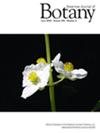The influence of elevation on genetic structure and variability in a wetland crucifer of the Rocky Mountains
Abstract
Premise
In mountain ecosystems, environmental conditions (e.g., temperature, ultraviolet radiation) covary with elevation, potentially limiting gene flow over steep gradients. We hypothesized that, (1) due to stark elevational differences in environmental factors, populations from dissimilar elevations (e.g., montane versus alpine) are more strongly differentiated than populations from similar elevations; (2) patterns of migration reflect downslope dispersal more than upslope dispersal; and (3) alpine populations at the cold edge show evidence of expansion, while montane populations at the warm edge have declined.
Methods
DNA polymorphisms in whole-genome sequences were studied from 6–10 genotypes each in populations of Cardamine cordifolia found at three montane sites (ranging from 2200 to 2800 m a.s.l.) and three alpine sites (ranging from 3000 to 3500 m a.s.l.). Statistical analyses assessed patterns of population structure, genetic diversity, migration, and historical demography since the Pleistocene.
Results
Populations maintained very high levels of nucleotide diversity (π range: 0.062–0.071) and were weakly differentiated (pairwise FST = 0.027) on average. Migration among alpine populations was also inferred, with no directionality of migration across elevation bands. Demographic inference suggests that both montane and alpine populations have declined in size since the Pleistocene.
Conclusions
Environmental differences across elevation represent diffuse barriers to gene flow. Recent polyploidy and clonal reproduction likely explain excess heterozygosity and high nucleotide diversity within populations. The genetic similarity of populations across elevation suggests highly connected refugia during the Pleistocene; such results may indicate that montane and alpine populations will respond similarly to changing environmental conditions associated with climate change.



 求助内容:
求助内容: 应助结果提醒方式:
应助结果提醒方式:


